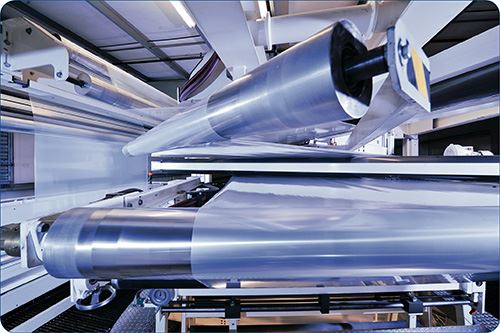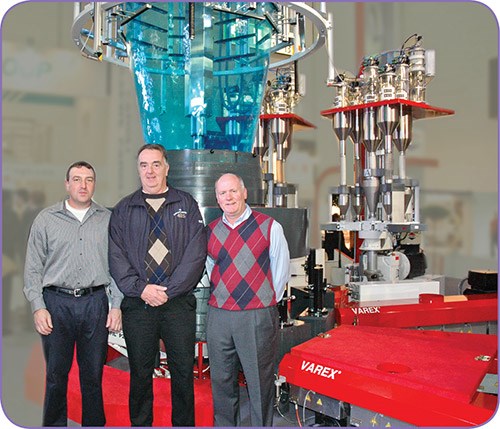On Site: Where Art, Science, And Customer Focus Meet
Business strategy at Danafilms involves a mix of art and science in blending resins, designing layer structures, and operating flexibility for both short and long runs.
There is nothing terribly complex about the business strategy at Danafilms, which for more than 40 years has been a growing supplier of mono- and multi-layer blown films. Its way of doing business isn’t all that different from what Sherman Olson had in mind when he started the company (danafilms.com) in Westboro, Mass., with $15,000 in start-up capital that he spent to build his own production machines: Keep it as simple as possible whenever possible. Success depends on providing the best quality and service in the industry. Invest profits back into state-of-the-art equipment and top-notch personnel.
Today, with more than 20 blown film lines at plants in Westboro and Franklin, Ky., 65 million lb of production capacity, 150,000 ft² of manufacturing space, 99 employees, and annual sales of approximately $70 million, those business basics still govern the day-to-day operations at Danafilms. “It sounds like a cliché, and everybody says it, but we live and breathe quality and service,” says Alan Simoncini, Danafilms’ general manager, who joined the firm in 1974 as an operator. “Do what you say you are going to do and do it on time. Serve customers with quality film that allows them to get the most from their equipment. Anything we send out the door we don’t want coming back.”
Danafilms’ customer-friendly approach can be seen it both its willingness and ability to fill orders of virtually any size. “To a lot of companies, a 5000-lb order is considered small,” Simoncini elaborates. “We’ll take orders that most competitors would consider too small if it might help a customer take an order themselves.”
Danafilms’ simple business strategy combined with state-of-the-art extrusion technology has allowed to company to grow each year it’s been in business, even during the so-called Great Recession of 2008-2009. “We certainly made some adjustments during that period, but the fact is we kept all of our employees and remained profitable,” Simoncini states. “It’s an age of consolidation where big companies are fighting for market share. To increase value for our customers and employees, we continue working leaner and smarter than ever.”
Danafilms participates in a wide range of markets, which helped provide some insulation from the economic tumult a few years back. It is a significant player in lamination films used in high-speed, hot-fill, lidding, confection, coffee,and quick-freeze applications, among many others. These films are frequently used to sandwich the reverse-printed side of PET or other films to protect the graphics from scratching.
Danafilms also furnishes what it terms “high-speed” films for candy, frozen food, and cough drops. These films have to provide a fast, secure seal to prevent the product from being blown through the bottom of the pouch. They are also a major player in hot-fill films and films for lidding, barrier applications, and forming/non-forming films for fresh or frozen meats, hot dogs, sausage, cheese, pizza, poultry, frozen fish, bakery, pasta, egg rolls, sandwiches, health care products, novelties, and more.
Not surprisingly, Danafilms runs a wide range of materials, including virtually every extrudable grade of PE and PP, along with nylon, EVOH, EVA, metallocene-based polyolefins, and more. What might be a bit unexpected is its continued emphasis on monolayer products. The lines in Westboro are all monolayer, provided primarily by Gloucester Engineering, and produce close to 40 million lb/yr. They run widths from 4 to 78 in. and thicknesses from 1 to 10 mils. All are furnished with gravimetric blending systems.
States Simoncini, “Monolayer films are not going away. We’ve been a leader in monolayer for 40-plus years and intend to stay that way.” But these are hardly low-tech commodity films. Danafilms has particular expertise in fine-tuning blends to produce monolayer structures tailored precisely to the end use, with properties that can be performance-related (mechanical strength, stiffness, sealability, thickness, or cost) or marketing-related (surface, clarity, gloss, printability).
WHERE ART MEETS SCIENCE
Ability to engineer material formulations to produce single-layer structures with properties competitive with multi-layer is an example of what Danafilms calls the “art” of blown film. “Make no mistake, there is a tremendous amount of science involved in what we do on a daily basis,” says Simoncini. “But there is a lot of art as well. We do a tremendous amount of changeovers on a line. There is an art to this. That’s where the money is. Then consider our operation in Westboro: how cold our winters are, and how hot it is in the summer. If you think there isn’t an art involved in keeping the bubble stable and keeping production parameters within specification under those circumstances, we’d disagree.”
On the “science” side, Danafilms uses small extruders as lab lines to reverse-engineer competing products and develop more effective solutions for customers. “We’ll also reverse-engineer what we do, and if it isn’t effective we go back to the drawing board,” states Simoncini. “We will do product sampling for customers trying to get into new markets, producing new structures specifically for them on a trial basis.”
In Westboro, Danafilms also has a fully equipped laboratory with digital-imaging microscopes to view layers and measure thicknesses; differential scanning calorimetry and Fourier transform infrared spectroscopy to determine polymer composition and location in a structure; equipment to measure water-vapor and oxygen transmission rates of films and laminated structures; and physical testing equipment to measure tensile strength, elongation, coefficient of friction, dart impact, Elmendorf tear, heat seal, haze, opacity, and gloss.
Danafilms expanded its product line and customer base in 2004 with the addition of its first ever seven-layer system, supplied by Windmoeller & Hoelscher, at its Kentucky plant. Whereas most film processors progress from monolayer to three and then five layers before moving up to seven, Danafilms skipped the normal progression and jumped from three to seven layers. “We felt strongly that being in three layers was not enough, so we moved right to seven,” says Simoncini. “Of course you can make five-layer film on a seven-layer line, which we do. So while the learning curve may have been steeper by going from three layers right to seven, it afforded us with greater flexibility and allowed us a generate a fuller slate of products.”
A second seven-layer W&H line was installed this past spring. The seven-layer lines run from 35 in. to 75 in layflat. Danafilms produces five-layer film with a nylon core layer for applications ranging from lawn and garden to bulk cheese to medical; and versions with an EVOH core layer for oxygen-barrier films, snacks, and shredded cheese, among others. It makes seven-layer structures in a PE/tie/nylon/EVOH/nylon/tie/PE configuration for chub packaging and institutional hot-fill liquids. Others with a nylon/PP skin (with or without EVOH) are for modified-atmosphere packaging, rising-crust pizzas, fresh-cut meats,and more.
“One of our founding principles was to reinvest capital constantly in new technology, and we are still guided by that,” says Simoncini. “People who don’t put money back into their operation are only hurting themselves in the long run because they won’t be around long with that approach.”
A recent 53,000 ft² expansion in Kentucky has room for “many, many more lines” beyond what is already housed there (and a 25-acre site leaves room for even more expansion). Danafilms has on order a new three-layer W&H line that Simoncini describes as “a unique line for unique things,” possibly including novel structures for an undisclosed market that Danafilms is seeking to enter. “We’re not locked into any technology in particular, whether it is one, three, or seven layers,” Simoncini states. “We expect most of our expansion to be in coextrusion, but in how many layers will depend on how we determine to best provide the customer with a solution.”
NEW AFFILIATION A BOOST
The company’s efforts to expand into new markets with new film products got a boost last year when it was acquired by RKW-Group of Frankenthal, Germany, a global film-extrusion powerhouse with 2800 employees. Still family-owned, RKW (rkw-group.com) has quadrupled in size over the past 12 years and has 19 facilities throughout Europe, Egypt, and Vietnam. Its specialties include industrial films, industrial packaging, consumer packaging, agricultural films, and personal-hygiene and medical films. “It might be an overused word, but a tremendous amount of ‘synergy’ was created by bringing Danafilms into RKW,” says Simoncini. “This is a leading-edge, technology-focused processor of high-performance films that was thrice named the supplier of the year by Procter & Gamble. “This acquisition will, among other things, facilitate our ability to develop new products and enter new markets.”
Aaron LaPointe, Danafilms’ coextrusion technical manager, puts it this way: “There’s great value in this relationship for both Danafilms and for our customers in this combination. It’s really nice knowing that I can pick up the phone anytime and talk to one of my peers in the RKW technical department. Similarly, RKW also brings a lot of complementary and new technology, which we look forward to being able to offer to all of our Danafilms’ customers.”
Related Content
Understanding the ‘Science’ of Color
And as with all sciences, there are fundamentals that must be considered to do color right. Here’s a helpful start.
Read MoreHow to Estimate and Control Head Pressure
You rightfully worry about melt temperature, but don’t overlook head pressure, because the two are closely linked and will influence line performance.
Read MoreSpecialty Purging Compounds Optimize Color and Material Changeovers
Selecting of the correct purging compound can speed up material and color changeover time and reduce scrap. You’ll even save on material.
Read MoreHow Polymer Melts in Single-Screw Extruders
Understanding how polymer melts in a single-screw extruder could help you optimize your screw design to eliminate defect-causing solid polymer fragments.
Read MoreRead Next
Why (and What) You Need to Dry
Other than polyolefins, almost every other polymer exhibits some level of polarity and therefore can absorb a certain amount of moisture from the atmosphere. Here’s a look at some of these materials, and what needs to be done to dry them.
Read MoreTroubleshooting Screw and Barrel Wear in Extrusion
Extruder screws and barrels will wear over time. If you are seeing a reduction in specific rate and higher discharge temperatures, wear is the likely culprit.
Read MoreProcessor Turns to AI to Help Keep Machines Humming
At captive processor McConkey, a new generation of artificial intelligence models, highlighted by ChatGPT, is helping it wade through the shortage of skilled labor and keep its production lines churning out good parts.
Read More

















.png;maxWidth=300;quality=90)














